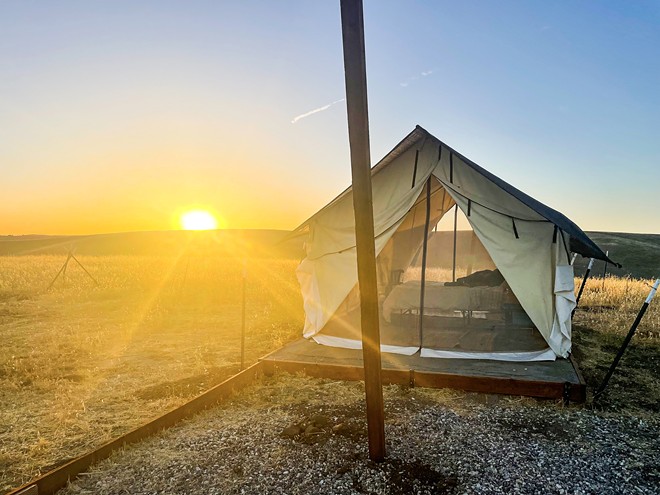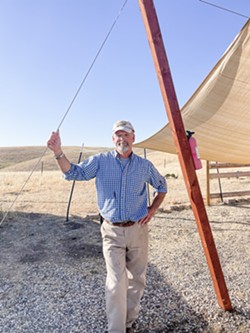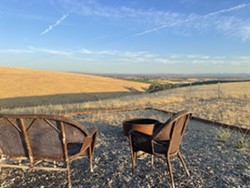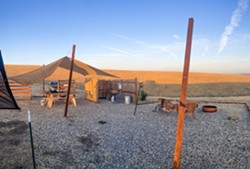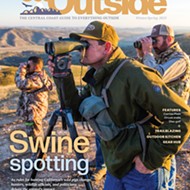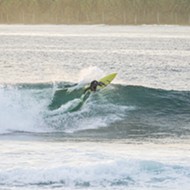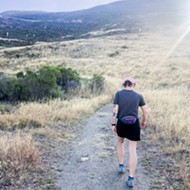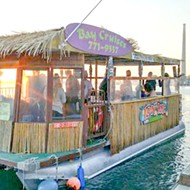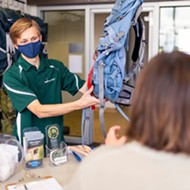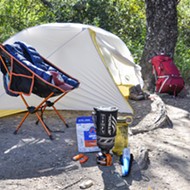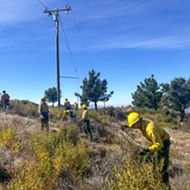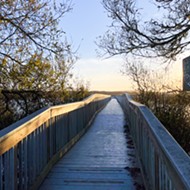FEATURE: As private camping experiences like Hipcamps grow in popularity and importance, county rules and guidelines lag behind
GET OUTSIDE - SUMMER/FALL 2022
By Peter Johnson[{
"name": "Ad - Medium Rectangle CC01 - 300x250",
"id": "AdMediumRectangleCC01300x250",
"class": "inlineCenter",
"insertPoint": "8",
"component": "2963441",
"requiredCountToDisplay": "12"
},{
"name": "Ad - Medium Rectangle LC01 - 300x250",
"id": "AdMediumRectangleCC01300x250",
"class": "inlineCenter",
"insertPoint": "18",
"component": "2963441",
"requiredCountToDisplay": "22"
},{
"name": "Ad - Medium Rectangle LC09 - 300x250",
"id": "AdMediumRectangleLC09300x250",
"class": "inlineCenter",
"insertPoint": "28",
"component": "3252660",
"requiredCountToDisplay": "32"
}]
Kenney Enney’s ranch in northern San Luis Obispo County butts up against the heart of Paso Robles’ wine country. Vines dominate the arid summer landscape east of San Miguel until the grapes give way to his 850 acres of grain, cattle, and untouched open space.
“My joke is I’m the defender of the rangeland,” said Enney. “Because when you come out here, you look south and see the vineyards come right up to my edge.”
The retired U.S. Marine colonel, whose plaid shirt is spotted with dirt after a day’s work, is not exaggerating. A ranch road winds for more than a mile on his property, up a hill to a vista point that shows the vineyards and wineries splaying in all directions throughout the valley below.
For Enney, growing grapes isn’t an option. Water restrictions over the Paso Robles Groundwater Basin prevent him and others from increasing their irrigation, so he’s all but stuck making a living off grains and cattle, a lifestyle that’s close to economically unviable these days.
“With the drought cycle that’s becoming shorter and shorter, it’s harder and harder to grow grain,” Enney said. “And the cattle is hardly bringing in anything at all.”
Veering off from the vista point, a dirt road connects two pads of gravel spaced about 50 yards apart. Each contains a large canvas tent with a bed inside, as well as picnic tables, fire pits, and other camping amenities.
About five years ago, Enney had the idea to put private campsites on his ranch. He thought back to his military days, when he’d stay in canvas tents overseas in sometimes beautiful and interesting places. At first, he wanted to host service members there as part of the Wounded Warrior Project, a nonprofit that offers support to veterans or active duty soldiers recovering from combat injuries.
“I wanted to showcase the nature out here and for them to enjoy the rangeland,” Enney said.
After hosting some retreats, one military visitor made the suggestion: Why doesn’t he rent out his four campsites to the public? In 2018, Enney signed up as a host on Hipcamp, an app that connects rural landowners with campers interested in unique outdoor experiences. At the time, the concept seemed relatively new for the area, he said.
“I looked at it like nobody else was doing it,” Enney said. “Every time you go camping in California, they cram you 10 feet away from someone else and [you have to reserve it] weeks in advance. And initially the idea was to have the campsites spread apart so you wouldn’t see another one.”
In the years since—especially since the start of the pandemic—Hipcamp and other platforms like it have taken off on the Central Coast, and across the state and country.
According to company data, SLO County now has more than 70 hosts, on properties ranging from “cattle ranches, to working vineyards, to family owned preserves and apple orchards” across 85,000 acres, and they inject $3.2 million per year of spending into the economy.
For Enney, the pandemic pushed his campsites to 80 percent occupancy as business went “gangbusters.” Priced at $75 per night each, he said the sites have become a crucial financial lifeline for his family and his ability to own and live on the ranch. On the flip side, they’re also a desperately needed respite for campers who were cooped up inside during the pandemic.
“During COVID, I had parents whose kids had not been outside for weeks. I had kids that came out here who didn’t realize there were that many stars,” Enney said. “I’m catering to young couples, young families that just want to unplug and go out and listen to the owls, coyotes, and cattle.”
Regulating recreation
Enney’s story is actually a common one among Hipcamp hosts, and it gets at the core of the company’s mission, according to Michal Rosenoer, a senior manager of government and community relations at Hipcamp.
“We really believe that opening up private land for outdoor recreation not only takes pressure off public spaces that we know are completely overrun and really impacted right now, but also supplies rural landowners, primarily farmers and ranchers, with the opportunity to develop a secondary revenue stream,” Rosenoer told Get Outside, “which is really important for keeping those lands undeveloped in the face of drought, rising costs, things like that. It’s a win-win for outdoor recreation and agriculture.”
While Hipcamp and its hosts see it that way, not everyone in the community is so enthusiastic about the new niche of agri-tourism. Critics raise concerns about fire safety, health and sanitation, noise, traffic, and other neighbor-to-neighbor impacts that stem from the private campsites.
Many of those concerns are valid, Enney said, especially absent clear rules and guidelines for the industry. As the number of Hipcamp sites proliferates, SLO County and many local jurisdictions lag behind in developing clear rules and permit processes to address them. In SLO, that’s caused angst for both hosts and community members.
“Today, our absence of rules is creating problems across the county,” SLO County Farm Bureau Executive Director Brent Burchett wrote in a letter to the Board of Supervisors last year. “We believe it is important to put clear rules in place that give the county the tools it needs to stop bad actors while creating a new opportunity for farmers, ranchers, and rural property owners.”
Enney described his experience of trying to permit his campsites with the county as “a battle.”
He said that since 2018, county officials have “changed their mind about four times” on what kind of permits he needs, and he’s been hit with multiple fines over the years totaling thousands of dollars. As a “retired military guy,” Enney said he wanted to follow the rules and be a good steward of the land, but the county doesn’t seem to know what it wants.
“It was easier to build my house out here then it was to put a tent up,” Enney said. “Every time I think I’ve done what they’ve wanted me to do, they came back to throw something else out. … I’m kind of at a point, honestly, where there’s no justification for what they’re doing. They’re blocking other people. I really feel sorry for some of the young families [who own ranches]. They don’t have any other options, really.”
Last year, amid calls from the community to address the regulatory issues, the SLO County Board of Supervisors directed its staff to develop a new ordinance for private rural camping like Hipcamps. The current applicable rules are outdated and expensive to follow, locals told the board. They limit what’s possible (like requiring 1,000-foot property setbacks for campsites) and don’t take into account issues like fire safety and neighborhood impacts.
According to Rosenoer of Hipcamp, SLO isn’t alone in its struggle to adapt its camping regulations to today’s world.
“In most counties, land use codes don’t address private land camping,” Rosenoer explained. “This land use is a really new concept. But because the code doesn’t address it, you have to go through some really expensive, long-term permitting processes—upwards of 18 months and sometimes upwards of $100,000—just to get a yes or no answer from the county about whether they think what you’re doing is appropriate or not.”
Over the past year, Rosenoer has worked directly with property owners in SLO County who have reached out for help understanding the county’s permitting system and to advocate for new regulations that provide a clearer path to success—even providing SLO a potential draft of an ordinance.
One of those locals, Mok Singh, a small vineyard owner in Paso Robles, said he wants to become a Hipcamp host after hearing the appeal from visitors to “be near the earth, sounds, sights, and smell of the viticulture environment.” But the current rules make that unattainable for him on his few dozen acres.
“I began looking into this and I noticed that the county had an ordinance with qualifications that were extremely onerous,” Singh said. “There are several farmers in our community who’d want to do something like this and would benefit from it. It’s extremely hard for a small farmer or a small viticulturalist to even break even on growing fruit and selling fruit because, unless you’re one of the really big players who have economies of scale as a benefit, our costs for producing wine grapes is so high that forget about being able to pay a mortgage, it’s hard to even sell the fruit for enough to pay for the farming practices. Quite frankly, I’d be in a position where if I couldn’t find other revenue streams to help, I’d probably have to sell my vineyard.”
While the ball is finally rolling for Hipcamps in SLO County, officials say it might take 18 months to develop the new ordinance. To Enney, who is still resolving his longstanding issues with the county, that’s too long.
“I’m looking at the future of agriculture in California,” Enney said. “To keep the rangeland rangeland, to keep it from getting gobbled up, to try to be a good steward of the land, camping’s an easy way to do it.”
Latest in Get Outside
Comments (5)
Showing 1-5 of 5

